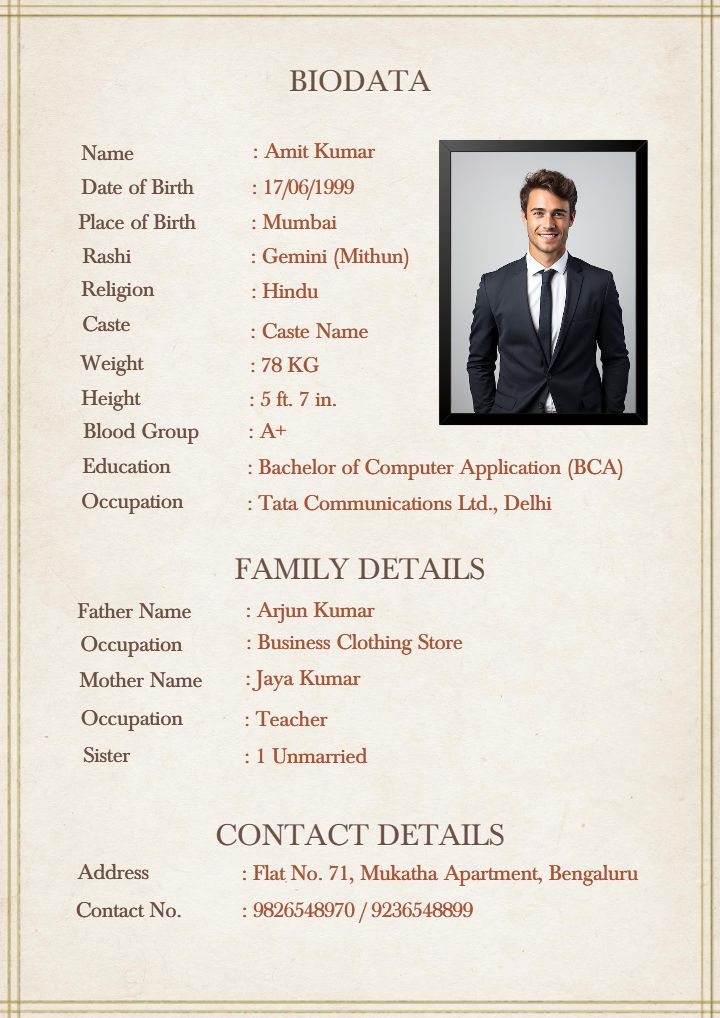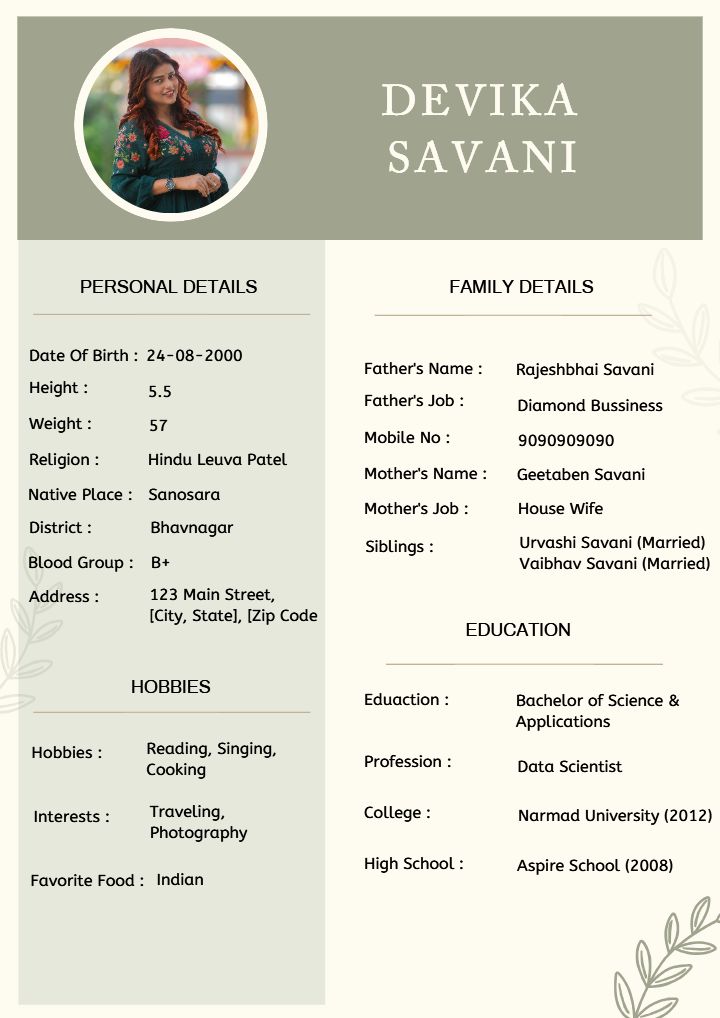Start Explore Marriage Biodata Templates
Get a Head Start with Fully Customizable Marriage Biodata Templates
63+ Marriage Biodata Templates
Wedding Biodata for Girl in Creative and Graceful Profile
Bio DataMarriage Biodata for Girl in Unique and Impressive Layout
Bio DataWedding Biodata for Girl in Graceful Heritage Design
Bio DataMarriage Biodata for Girl in Stylish and Cultural Layout
Bio DataMale Biodata for Marriage with Complete Profile Details
Bio DataMarriage Biodata for Boy with Modern Creative Design
Bio DataCharming Biodata for Marriage with Stylish Layout
Bio DataElegant Marriage Biodata Template for Perfect Match
Bio DataStylish and Professional Marriage Biodata for Boy
Bio DataStylish Marriage Biodata Template Design for Bride
Bio DataEasy-to-Fill Marriage Biodata for Female Template
Bio DataStylish Marriage Biodata for Female with Image
Bio DataProfessional Marriage Biodata for Female Template
Bio DataMarriage Biodata Templates With Unique Biodata Format for Marriage
A marriage biodata, also called a matrimonial resume, is a paper that shows all the important details about a person. It tells about their personal life, family, and work. People usually use it for arranged marriages.
The modern biodata format for marriage or marriage biodata Word format helps future partners and their families know each other’s background, values, and compatibility.
Making a well-structured and complete canvas marriage biodata is very important to give a good first impression. You can choose a stylish biodata format for marriage or a detailed marriage biodata, but the right template for biodata for marriage makes it clear and professional.
If you want it to be easy, you can use a marriage biodata format in Word. It's simple to change the words, and you can make it look just how you want. If you want your biodata to look pretty, there are special aesthetic biodata for marriage designs that can help your profile look nice. Some places give you a free biodata for marriage template, and others have paid ones with extra fun features. Whether you need a wedding resume format, biodata resume, CV for marriage, marriage CV format, or a biodata for marriage in English, picking the best bio data format for marriage helps you show who you are in a great way.
Some people might like using a marriage biodata PPT template to make their information look fun and exciting. Others might want a marriage bio data form PDF free download so they can share it easily. The newest bio data format for marriage has clean designs and cool fonts to make it look nice. If you’re looking for a bio data for marriage template free, Crafty Art has ready-made marriage biodata designs that you can change how you want. For people who like a clear plan, a bio data marriage format or biodata word template for marriage helps you add all the important details. Whether you pick a free marriage biodata template or a paid one, the most important thing is to make your marriage bio-data look professional and fun.
If you want it to be easy, you can find a marriage biodata template download free from trusted places. A nice biodata for marriage format in Word or a biodata for marriage template free download Word is easy to use and change. The best template of biodata for marriage helps show who you are and can help you find someone special. Whether you pick a bio data design for marriage with fun details or a simple bio data format for marriage, the goal is to make a biodata that tells everyone about the real you.
Design Your Perfect Marriage Biodata with Crafty Art
Your biodata is more than just a document; it's your introduction to a potential life partner and their family. By choosing a template that reflects your personality, values, and aspirations, you can make a memorable impression and pave the way for meaningful connections. Whether you prefer classic elegance, modern minimalism, creative expression, cultural fusion, or tech-savvy sleekness, there's a matrimonial biodata template to suit every style and preference. So, embrace the opportunity to showcase your uniqueness and embark on the journey of finding your perfect match.
Creating the perfect biodata templates for marriage is crucial for anyone seeking to make a memorable first impression. At Crafty Art, we understand the importance of a well-crafted wedding biodata that highlights your personality, achievements, and aspirations. Our platform offers a variety of biodata templates for marriage designed to suit different tastes and preferences, ensuring you find the perfect match for your needs.
Using our biodata builder, you can effortlessly create biodata that stands out. Our intuitive maker app simplifies the process, allowing you to input your details and customize the marriage resume template with a marriage resume format to reflect your unique style. Whether you prefer a traditional layout or a modern design, our biodata templates for marriage or marrige CV cater to all preferences, ensuring that your wedding biodata leaves a lasting impression.
Why Choose Crafty Art for Unique & Stylish Biodata Templates for Marriage
When it comes to creating a first impression in the world of matrimonial alliances, a unique biodata for marriage can make all the difference. Crafty Art understands this deeply and offers a wide range of customizable designs that blend tradition with style. Whether you're looking for a modern biodata format for marriage, marriage biodata-word format for girl or a unique marriage biodata format, Crafty Art provides modern marriage biodata templates that perfectly reflect your personality and cultural roots.
What sets Crafty Art apart is its professionally crafted layouts, making it a go-to platform for anyone seeking a professional biodata format for marriage or a clean and elegant professional biodata for marriage. You can explore ready-to-edit options like the marriage biodata Google Docs template, making it simple to access, edit, and share from anywhere.
From vibrant and creative biodata for marriage styles to minimalistic and refined designs, our Google Docs marriage biodata template options cater to every taste. If you want to make a statement with your biodata, our stylish biodata for marriage collection is sure to impress. Plus, with marriage biodata template free download options, you can get started without spending a dime.
Choose from a range of formats including the latest modern marriage biodata format, downloadable marriage biodata template Google Docs, and easy-to-use layouts tailored for a modern biodata for marriage experience. Whether you need a unique bio data for marriage or a professional marriage biodata format, Crafty Art ensures every detail is well taken care of.
We also provide unique biodata format for marriage, fancy biodata for marriage, and the most trendy biodata new format options with stunning canvas bio data for marriage designs and stylish marriage biodata format layouts that truly stand out.
How to Create a Professional Biodata for Marriage with Crafty Art
Creating a marriage biodata that stands out is essential to make a lasting impression. With Crafty Art, you can design an attractive biodata for marriage effortlessly. Follow this step-by-step guide to craft the best biodata for marriage using our modern bio data for marriage templates.
Crafty Art offers a wide range of biodata template background options and elegant bio data background image selections to make your profile look visually stunning. You can explore our bio data template free download section for quick and easy creation. For users looking for unique styles, we provide marriage biodata background images and wedding biodata templates that cater to traditional and modern tastes. Whether you're designing a biodata for 2nd marriage or your first, our marriage CV templates serve every need. If you prefer working with editable files, you’ll love our marriage biodata PSD free download options.
Need something trendy? Our collection includes the latest biodata for marriage along with a free biodata template library. Whether you’re a simple biodata maker or someone looking for elegant bio data free template options, Crafty Art makes the process seamless. You can even design your marriage biodata in English effortlessly using our tools to create a polished biodata for marriage English version ready for sharing.
Choose the Right Template
Start by selecting the best template for marriage biodata from Crafty Art. Whether you need a simple biodata format for marriage or a fancy biodata format for marriage, we offer a variety of options, including marriage biodata template docx, marriage biodata template Word and wedding resume template.
Personalize Your Information
Fill in your details in the matrimony biodata template. Include essential sections like family background, education, career, and hobbies. Our creative biodata template for marriage ensures your profile looks structured and professional.
Enhance with Creative Design
Make your biodata visually appealing with creative biodata design for marriage. Crafty Art provides canvas marriage biodata and creative marriage biodata options to add a unique touch.
Review & Download
Proofread your marriage bio data sample to avoid errors. Once finalized, download your marital biodata in your preferred format, such as bio data new format or marriage resume templates.
Share with Confidence
Your attractive marriage biodata format is now ready! Share it with potential matches and leave a lasting impression.
With Crafty Art, you gain access to both traditional and modern biodata template background themes that suit every cultural preference. Add a touch of elegance with a professional bio data background image that complements your personality. Explore our vast library offering bio data template free download, including high-quality marriage biodata background images ideal for digital or print use. Whether you're preparing a biodata for 2nd marriage or a first-time wedding introduction, you’ll find options ranging from marriage biodata PSD free download to wedding biodata templates that suit every need.
Create the latest biodata for marriage with our user-friendly editor and enjoy access to free biodata template designs. Whether you’re a beginner using a simple biodata maker or looking for a refined biodata free template, Crafty Art provides an easy experience. Plus, with the option to craft your marriage biodata in English, you can present your details confidently using our polished biodata for marriage English layout.
Importance of a Marriage Biodata
A well-prepared marriage biodata format in English serves as your personal introduction in the search for a life partner. Using an online free marriage biodata maker ensures your profile is structured, professional, and appealing. Whether you need a bio data for marriage free maker or the best marriage biodata maker, Crafty Art provides tools to make marriage biodata online effortlessly. A strong biodata not only highlights your qualities but also increases your chances of finding the right match.
First Impressions:
Your attractive free bio data for marriage format is often the first impression you make on a potential match and their family. A well-crafted professional marriage biodata reflects your personality and seriousness about finding a life partner. With a marriage biodata maker free, you can create a polished profile that stands out. Tools like a free wedding biodata maker or marriage resume maker help design an impressive biodata quickly and easily. Writing about myself for marriage biodata is also more important.
Clarity and Transparency:
It provides clear and transparent information about your background, making it easier for both parties to assess compatibility. Using a free bio data maker for marriage ensures all essential details are presented neatly. Whether you choose a traditional or modern mrg biodata maker, a well-structured biodata eliminates confusion and builds trust from the start.
Family Involvement:
In many cultures, families play a significant role in marriage decisions. A detailed marriage CV and marriage CV word format help families make informed choices. With an easy-to-use marriage biodata maker free, you can create a profile that satisfies both personal and family expectations, ensuring a smoother matchmaking process.
Time-Saving:
A comprehensive biodata can save time by providing all necessary information upfront, reducing the need for repetitive questions. By using a best marriage biodata maker, you can quickly make marriage biodata online and focus on meaningful connections rather than paperwork. Crafty Art’s tools help streamline the process, making your search for a life partner efficient and stress-free.
Tips for Crafting an Effective Biodata for Marriage
Creating a compelling marriage biodata format in English or marriage biodata template Word format is essential for making a strong impression. Whether you use a free online marriage biodata maker or free biodata format PNG, ensure your profile reflects your personality. Tools like the best free biodata maker for marriage or a free biodata generator can help streamline the process. For those looking to biodata for marriage edit or customize, platforms like Crafty Art offer a male marriage biodata maker free for marriage options that simplify biodata for marriage making.
Be Honest and Accurate:
Authenticity is crucial. Misleading information can lead to complications later.
Keep It Concise:
Aim for clarity and brevity. A stylish biodata format for marriage template should be easy to read and comprehend.
Highlight Strengths:
Emphasize your positive attributes and achievements without exaggerating.
Update Regularly:
Ensure your latest biodata format for marriage is up-to-date with your latest details and accomplishments.
Use a Clean Layout:
A neat, well-organized best biodata format for marriage proposal makes a good impression. Use bullet points and headings to enhance readability.
For a seamless experience, try a biodata maker online free tool like Crafty Art’s biodata maker, which offers bio data for marriage online free solutions. Whether you need a biodata free maker or assistance in biodata making for marriage, Crafty Art ensure a professional and polished profile.
Different Types of Biodata Templates for Marriage
Choosing the right biodata format is essential for making a strong impression in your matrimonial search. With our free marriage biodata online tools, you can create free marriage biodata in various styles to match your personality. Whether you prefer a classic, modern, or creative approach, our online biodata editor makes customization easy. Explore online marriage bio data templates that suit your needs, all available as marriage biodata for free, ensuring a seamless and professional presentation.
Traditional Biodata Template:
Conventional and professional biodata format for marriage or bio data for marriage format in Word with sections for personal, family, education, career, and partner preferences.
Modern Biodata:
Sleek bio data design for marriage or marriage biodata design, concise sections, may include social media links, suitable for a minimalist approach.
Creative Biodata Templates:
Vibrant colors, for unique biodata for marriage proposal, use best fonts, allows artistic expression, ideal for showcasing talents and interests.
Professional Biodata:
Emphasizes education, career achievements, and goals, tailored for career-oriented individuals with the help of our biodata marriage template.
Multicultural Biodata:
Incorporates cultural identity and traditions, facilitates compatibility across diverse backgrounds.
Eco-Friendly Biodata Templates:
Promotes sustainability, includes eco-friendly lifestyle choices and values, appeals to environmentally conscious individuals.
Crafty Art provides a marriage bio data maker free tool that lets you design the perfect profile effortlessly. Our free biodata creator supports various styles, from traditional to contemporary, ensuring your biodata stands out. You can also enhance your profile with a stunning bio data background design or choose from our collection of background for biodata options, including biodata background PNG files.
Whether you need an elegant biodata background design or a simple background for bio data, our platform offers endless customization possibilities. Try our free bio data maker online today and create a biodata design background that reflects your personality! With our free matrimonial female marriage biodata maker, designing an impressive marriage biodata has never been easier.
Explore the Best Biodata Format for Marriage – Modern, Creative & Traditional Styles
When it comes to finding the perfect life partner, a well-crafted marriage biodata format in English plays a crucial role. At Crafty Art, we offer a marriage biodata format free online that helps you create an impressive profile effortlessly. Whether you prefer a latest biodata format for marriage with a modern touch or a wedding biodata format English with traditional elegance, our modern biodata template for marriage caters to all needs. With our free online marriage biodata maker, you can make biodata for marriage free online without any hassle, ensuring your profile stands out.
For those seeking a second marriage biodata format word or a biodata format for second marriage, Crafty Art provides customizable options to suit your preferences. Our 2nd marriage biodata format is designed to highlight your background and aspirations effectively. You can also download a biodata format PNG for high-quality prints or digital sharing. Our free biodata maker online tool ensures a seamless experience, allowing you to make online biodata for marriage free in just a few clicks.
Looking for a free template for marriage biodata? Crafty Art offers a variety of online bio data template options to match your style. Whether you need a bio data editor free tool or a free bio data template for marriage, we have you covered. Create a polished and professional free biodata marriage profile with our easy-to-use platform. Explore our collection today and make your matrimonial journey smoother with the perfect biodata!
Create Stunning Marriage Biodata with Crafty Art’s User-Friendly PDF Templates
For unique biodata format for marriage, one of the key features of our service is the availability of the bio data for marriage PDF-biodata new format option. This ensures that your wedding biodata can be easily shared and viewed on any device, maintaining its integrity and formatting. With Crafty Art, you can create biodata that is not only visually appealing but also professionally structured, making it easy for potential matches to get to know you better.
Our marriage biodata maker is designed to be user-friendly, enabling you to craft a comprehensive and engaging wedding biodata without any hassle. The bio data maker app includes various templates that you can personalize with your information, photos like biodata template with photo, and other details, ensuring that your biodata templates for marriage are both unique and informative.
Crafty Art’s biodata builder ensures that every aspect of your wedding biodata is thoughtfully crafted. With our platform, you can create biodata that truly represents you, making your search for a life partner a seamless and enjoyable experience. Choose Crafty Art for the best biodata templates for marriage, and make a lasting impression with your well-designed wedding biodata.
Creating a marriage biodata is an essential step in many cultures when preparing for marriage proposals. It's a personal document that provides vital information about the individual, their family background, education, and preferences for a life partner. For anyone new to this process, understanding the correct biodata latest format or sample format of modern biodata for marriage can be confusing.
With the numerous best template for marriage biodata available, you may feel overwhelmed by the options. Luckily, finding a biodata marriage format download, marriage biodata template free download in word or a sample for biodata of marriage proposal is easier than ever, thanks to the availability of pre-designed matrimony biodata template, matrimony resume format online or bio data for marriage online format.
A well-organized sample format for marriage biodata or sample for marriage biodata ensures that all necessary details are clearly communicated, making it easier for families and potential matches to understand your background and values. Whether you're looking for unique bio data for marriage template free download or want to explore different marriage bio data formats, choosing the right bio data format for marriage template can make a significant difference.
A neatly crafted format for matrimonial biodata or marriage biodata sample format not only showcases your details in an organized way but also leaves a lasting impression. With resources like a template for marriage biodata or even a free download marriage biodata sample, sample bio data format for marriage, creating a professional and visually appealing marriage biodata template docx document has become more convenient than ever.
With Crafty Art, crafting the best biodata format for marriage is simple, stylish, and effective. Try our creative bio data for marriage today and stand out in the matrimonial search!
Explore Top Template Categories :
Customer Reviews
4.6 out of 5
5 customer ratings
5 star
60%
4 star
40%
3 star
0%
2 star
0%
1 star
0%
Why did you leave this rating?
Amazing, above expectations!
Our Customer Feedback
Don’t take our word for it. Trust our customers

Kunal Joshi
“Just wanted something simple but nice, and I ended up making a super attractive biodata for marriage here. It had a clean layout, icons for hobbies, and even space for family details. My friends are now asking where I made it 😂. This site is really underrated – good job Crafty Art!”

Priya Nair
“I tried so many tools but this was hands down the best marriage biodata maker online. The layouts are elegant, the colors are subtle, and everything looked so presentable. I loved how I could customize everything easily and create a PDF in minutes. Even my relatives abroad said the biodata looked amazing!”

Aman Verma
“Dude! I didn’t expect a fancy biodata for marriage to be this easy to make. Crafty Art made it super simple. I just chose the design, filled my info, and boom – it was ready to send on WhatsApp. My mom was really impressed too 😂. If you're looking to make something that stands out, this is the place!”

Sneha Patil
“I was searching for something unique and ended up creating the most creative biodata for marriage on Crafty Art! It wasn’t the usual boring format, it had personality and style. Loved the fonts and icons. Only wish they had more Marathi language options, but still it worked so well. Thank you Crafty team 💖”

Rohit Shah
“I was super confused about how to make my marital biodata but then Crafty Art came to the rescue. Their templates are so neat and clean, and honestly, my biodata looked like it was made by a designer. I got a lot of compliments from relatives too 😄. Easy to edit, lots of modern styles, and everything fits perfectly. Highly recommended!”
Have more Questions?
See our help center or send us a message!
FAQs for Marriage Biodata
What is the best free online tool to create a marriage biodata?
How can I download a biodata format for second marriage?
What's the difference between traditional and modern biodata formats?
Can I edit my biodata after creating it?
Are there creative biodata templates for artistic professionals?
Features
Create Invitation
Wedding
Baby Shower
Puja
Funeral
Gender Reveal
Inauguration
Caricature Maker New




















